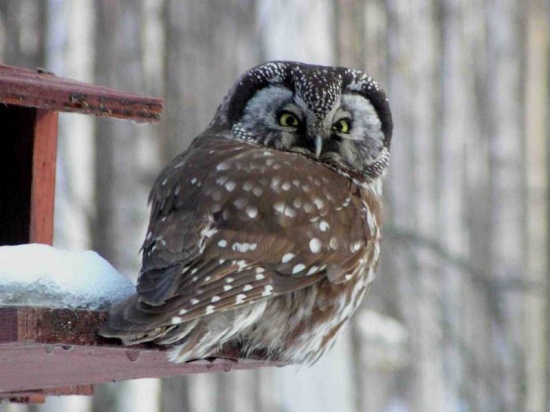Alternative name: Tengmalm's Owl
- Aegolius funereus
Identification
The Boreal Owl is 22-27 cm long with a 50-62 cm wingspan.
It is brown above, with white flecking on the shoulders. Below it is whitish streaked brown. The head is large, with yellow eyes and a white facial disc, and a "surprised" appearance.
Young birds are chocolate brown.
Distribution
This bird breeds across northern North America and Eurasia, and in mountain ranges such as the Alps and the Rockies.
This species is not normally migratory, but in some autumns significant numbers move further south. It is rare any great distance south of its breeding range, although this is partly due to the problems of detecting this nocturnal owl outside the breeding season when it is not calling.
Taxonomy
This small owl is known as Tengmalm's Owl in Europe after the Swedish naturalist Peter Gustaf Tengmalm.
This species is a part of the larger grouping of owls known as typical owls, Strigidae, which contains most species of owl.
Subspecies
There are 6 subspecies[1]:
- A. f. funereus :
- Northern Scandinavia to Pyrénées and Urals (except for Caucasus Mountains)
- A. f. caucasicus:
- Northern Caucasus Mountains
- A. f. pallens:
- A. f. magnus:
- North-eastern Siberia (Kolyma to Kamchatka Peninsula)
- A. f. beickianus:
- A. f. richardsoni:
Habitat
Dense coniferous forests.
Behaviour
It is largely nocturnal.
Flight
The flight is strong and direct.
Diet
This smallish owl eats mainly voles and other mammals but also birds as well as insects and other invertebrates.
Breeding
It lays 3-6 eggs in a tree cavity.
Vocalisation
References
- Clements, J. F., T. S. Schulenberg, M. J. Iliff, D. Roberson, T. A. Fredericks, B. L. Sullivan, and C. L. Wood. 2018. The eBird/Clements checklist of birds of the world: v2018. Downloaded from http://www.birds.cornell.edu/clementschecklist/download/
Recommended Citation
- BirdForum Opus contributors. (2024) Boreal Owl. In: BirdForum, the forum for wild birds and birding. Retrieved 19 April 2024 from https://www.birdforum.net/opus/Boreal_Owl




